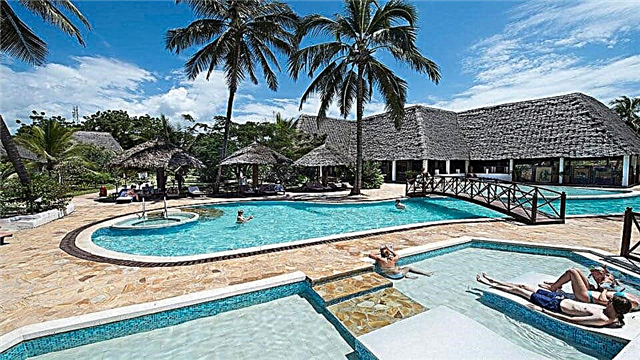The history of Bryansk began in the 10th century with the construction of a defensive fortress, which eventually turned into one of the important cultural and spiritual centers of Southwestern Russia. Unfortunately, even its ruins have not survived to this day. However, the serious development of the region began only during the time of Peter the Great, when Bryansk was chosen as a transshipment base for organizing the Azov campaigns.
There are many noteworthy tourist sites in the city: Orthodox churches, memorials in honor of the defenders and heroes of the Great Patriotic War, museums and theaters. The picturesque Dvina flows through Bryansk, whose right bank rises impressively above the water surface, and the left bank is dotted with small sandy spits.

The best hotels and hotels at affordable prices.
from 500 rubles / day
What to see and where to go in Bryansk?
The most interesting and beautiful places for walking. Photos and a short description.
Mound of Immortality
Monument in honor of the fallen during the Great Patriotic War. It stands on top of an artificial hill in the Nightingales Park. The monument is made in the form of pylons that fold into a five-pointed star. There is a wide area around, from where the left bank of the Desna is clearly visible. The land for the creation of the mound was brought from mass graves located in the Bryansk region and the hero cities of the USSR. The monument was erected in the period 1967-1972.

Boulevard Gagarin
1 km long pedestrian street in the historic center of Bryansk. It starts with a staircase in the coastal part and then turns into a gentle alley. The original name of the place is Christmas Mountain in honor of the Church of the Nativity of Christ destroyed during the Soviet era. A monument to Yu.A. Gagarin is erected on the boulevard (the cosmonaut visited Bryansk in 1966 and walked along this street). Most of the houses were built in the 19th century.

Pokrovskaya mountain
There are two famous monuments on Pokrovskaya Hill: a sculptural group depicting the hero Peresvet, a participant in the Kulikovo battle, and a guslar Boyan, as well as a monument in honor of the 1000th anniversary of the city, made in the form of a stele and the crowning figure of a woman with a hammer and sickle. Along the edges are other figures: a soldier, a worker and a revolutionary. A beautiful panorama of the city and the banks of the Desna opens from the top of the mountain.

Partizan Square
The modern Partizan Square arose on the site of the historic Khlebnaya Square, which was on the city plan back in the 18th century. Its main attraction is the monument to the liberators of Bryansk, erected in the 1960s and glorifying the feat of the soldiers and partisans of the Bryansk region. The monument consists of a 22-meter Victory Obelisk and sculptural groups on the sides depicting partisans and warriors.

Bryansk Regional Museum
The museum was opened in 1921. The basis of his collection was made up of property confiscated from churches and noble estates. Before the German occupation during the Second World War, the number of exhibits exceeded 2000, but these funds were destroyed. The institution reopened in 1949, the material for the exhibitions had to be collected again. Today the exposition consists of several sections dedicated to archeology, the nature of the region, ethnography and history.

Tkachev Brothers Museum
A. P. and S. Tkachev - Russian painters, natives of the Bryansk province. A museum in their honor was opened in 1995 on the territory of a small mansion of the early 20th century, located not far from the brothers' family house, which was destroyed during the Second World War. The collection consists of paintings, personal belongings, documents related to the life and work of artists. The museum offers interesting thematic excursions.

Tolstoy Drama Theater
The oldest theater in the region, founded in 1926. It is located in the building of the former House of Soviets, erected by the Moscow architect A.Z. Grinberg at the same time. It is a mixture of classical style and Soviet constructivism. The main entrance is designed as a traditional colonnaded portico and is decorated with stucco bas-reliefs. The structure was destroyed during the Second World War and rebuilt in 1949.

Bryansk Theater for Young Spectators
Basically, the theater's repertoire is focused on children and adolescents, but there are also performances for adults - plays based on the works of Shakespeare, Pushkin, Ostrovsky, Moliere and other playwrights. In 2013, the stage was merged with the Bryansk Regional Puppet Theater. The performances take place in a late classicist building built in 1960. The troupe regularly goes on tour, participates in festivals and does charity work.

Trinity Cathedral
The cathedral was erected in 2012. He became the successor of the temple destroyed in 1968. Until the end of construction work, the Resurrection Church was considered the main religious institution of the city. The building is a classic quadrangle, ending with decorative arches and topped with five domes. Nearby is the Peresvet bell tower, which reaches a height of 80 meters. A dome with a cross is erected on its top.

Church of the Resurrection
An Orthodox church built in the classical and Baroque style in the middle of the 18th century as a cathedral of the Resurrection Women's Convent, which ceased to exist in 1766. Paintings of the 19th century have been preserved inside the building. As a result of the restoration of the 1980s, the building regained its historical appearance (in the 1930s, it suffered significant damage after it was closed and converted into a consumer services plant).

Cathedral of the Intercession
The Intercession Cathedral is located on the mountain of the same name. It is considered the oldest temple in Bryansk. The stone building was erected in 1698 to replace the wooden church of 1603, which stood for almost a century. Funds for the construction were allocated by the steward ET Alymov. At the beginning of the 19th century, the bell tower was rebuilt. In architectural terms, the building is a mixture of the traditions of Russian architecture of the 17th century with the techniques of Naryshkin Baroque.

Spaso-Grobovskaya church
Orthodox church of the early XX century, built with money from the church elder and merchant P. S. Mogilevtsev. The Bryansk architect N. Lebedev worked on the project and chose the neo-Russian style for his creation. The name "Spaso-Grobovskiy" temple received due to the fact that it was erected on the burial site of Nektarios and Nathanael - local bishops. In the 1930s, the church was closed and its upper part was destroyed, restoration began in the 1980s.

Gorno-Nikolsky temple
The main temple of the Gorno-Nikolskaya monastery, built in the 17th century in the Baroque style (the bell tower has pronounced features of classicism). It has survived to this day practically unchanged, only the internal painting has not survived. In Soviet times, an archive and a planetarium were located inside; in 1999, the building was transferred to the Russian Orthodox Church. The monastery on the basis of the temple was founded in 2002.

Petro-Pavlovsky Convent
The monastery is the oldest in the Bryansk region, it was founded at the end of the XIII century. However, the oldest buildings that have survived to this day date back to the 18th century. The first time the monastery was abolished in 1830, but three years later it was revived as a woman's. The re-closure took place in the 20th century after the arrival of Soviet power. In 2002, monastic life resumed.

Svensky monastery
A men's monastery, founded, according to unconfirmed reports, in 1288. Written references to the monastery can be found in the sources of the 16th century, when, by order of Ivan the Terrible, two stone churches were erected on this place. Most of the buildings belong to the so-called suburban baroque, characteristic of the church building of Ukraine in the 17th century.Initially, the institution was called the Svinsky Monastery, but later it was renamed to avoid misunderstandings.

Park-Museum named after A. Tolstoy
City Park, founded in 1936. It bears the name of A. Tolstov, who was born in the Bryansk region and spent the last years of his life in his childhood home. According to the original project, the creators planned to place an exposition dedicated to the writer on the territory, but this did not happen. The park has a collection of interesting wooden sculptures that adorn the alleys, attractions and cafes are open for visitors.

"Partisan glade"
A memorial complex located 12 km from Bryansk in the very place where during the Second World War partisan detachments met to coordinate and plan further actions against the German invaders. The gradually formed sculptural ensemble includes a 20-meter obelisk, marble steles, a memorial wall, a museum, an exhibition of military equipment, a Memory Alley and an Eternal Flame.

"Hatsun"
During the Second World War, German troops shot more than 300 civilians in the village of Hatsun and burned down all their houses. A memorial in honor of the victims was erected in the 1980s, but it soon fell into disrepair. In 2011, on the day of the 70th anniversary of the tragic events, the renovated complex of monuments was solemnly opened. Today it includes a museum, a mass grave, steles with memorial plaques, a wall of memory and a chapel.

Museum-reserve of F. I. Tyutchev "Ovstug"
Ovstug is the Tyutchevs' family estate, located in the village of the same name (they owned the estate since the second half of the 18th century). Unfortunately, the historical buildings have not survived, since after the nationalization of property in the first years of Soviet power, they were dismantled for building materials. The master's house was recreated in the 1980s, after which a museum named after V.I. F. Tyutchev.

Desna river
The Desna is a left tributary of the Dnieper; it flows through the territory of Russia and Ukraine. Since ancient times, it was considered an important transport artery connecting the lands of Kievan Rus with the area along the Don and Oka. On the Desna there is Bryansk and several villages of the region and neighboring Smolensk region. Today the river is considered one of the most beautiful in Eastern Europe.












